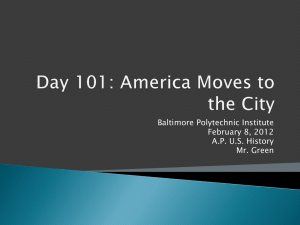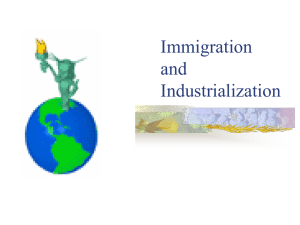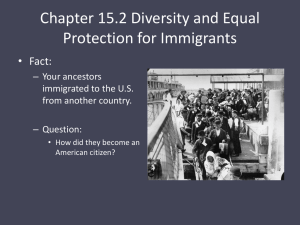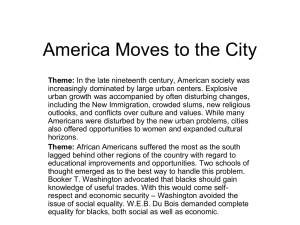Mental Hygiene
advertisement
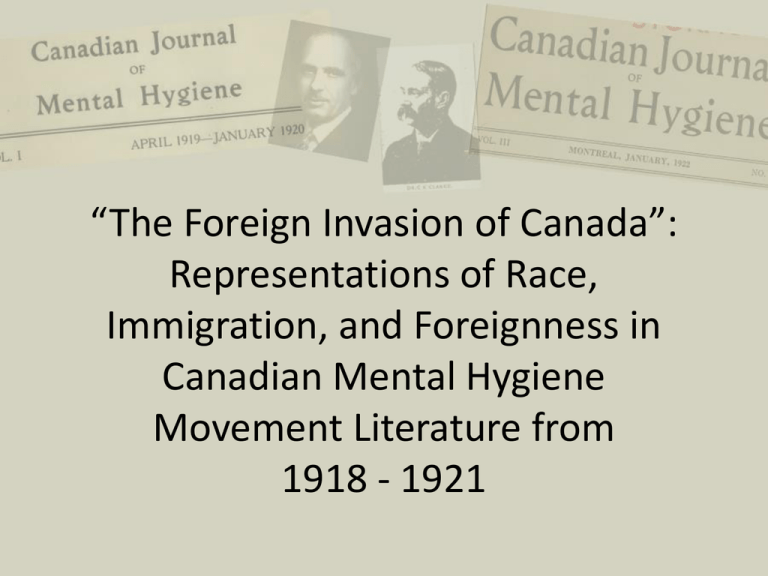
“The Foreign Invasion of Canada”: Representations of Race, Immigration, and Foreignness in Canadian Mental Hygiene Movement Literature from 1918 - 1921 Research Problem Mental hygiene is “the prevention of mental disorders and the promotion of mental health for the enrichment of human life” (Fitzgerald & Fleming, 1932, p. 15). Research Problem This study aims to examine discourses of race, foreignness, and immigration that underlie early Canadian mental hygiene movement (CMHM) literature from 1918-1921 and its connection to contemporary practices. Research Problem Rushing to practice is “a refusal to engage with learning about social violence, such as colonialism, racism and slavery” (Pon, 2009, p. 69) Research Design - Critical Discourse Analysis - discourse as a text - discourse as discursive practice - discourse as social practice Research Findings • Purpose of CJMH • Nationalism, Colonialism and Canadian Identity • Representation of Immigrants and Racialized People – – – – Fundamentally Foreign Prone to Mental Illness and Pathology Criminality Burden to Society • Eugenics and Immigration – – – – Eugenics Immigration and ‘Reverse Eugenics’ Concerns Around Racial Mixing Immigration Policy Purpose of CJMH • “in order to give impetus to the mental hygiene movement and bring it before the public” (Foreword, 1919). • “The CJMH hopes to interest the general public, as well as the medical professional, in all the mental problems confronting the community, in their bearing upon the welfare of the individual and of society, and in the work which is being done towards their clearer definition and more adequate solution.” (p. 3) Nationalism, Colonialism and Canadian Identity • In The Scope and Aims of the Mental Hygiene Movement, Hincks (1919) stated, “the brains of a nation constitute its most important asset. No country can be truly great, and remain so, with a population possessed of mediocre mentality. Natural resources may be necessary for the success of a country, but alone they are not sufficient, and perforce must take second place to human resources” (p. 20) Nationalism, Colonialism and Canadian Identity • This idea can be seen in Sir James Barr’s statement, quoted by Page (1919), “You have, here, a virgin soil and you should see that is peopled with a vigorous and an intellectual race. You should shut out all degenerate foreigners as you would exclude a mad dog” (p. 59). • Violence of colonialism made invisible Nationalism, Colonialism and Canadian Identity • Smith (1920) for the purpose of examining immigration statistics, “group[ed] the Canadian, British and American (because of “Springing from Common Stock”) [together and] add[ed] the Scandinavian and French (who are “quickly Canadianized”)” (p. 76). • Fauman (1920) explained, “In return for the privileges of citizenship granted the immigrant, his complete and rapid Canadianization is desired” (p. 323). Immigrants and Racialized People Represented as Fundamentally Foreign • the native of India was not regarded as “a person suited to this country; that accustomed as many of them are to the conditions of a tropical climate, and possessing manners and customs so unlike those of our own people, their inability to readily adapt themselves to surroundings entirely different could not be other than entail an amount of privation and suffering which render a discontinuance of such immigration most desirable in the interest of the Indians themselves” (p. 215) • “And the first outstanding feature is that [the Chinese] do not assimilate rapidly or easily.” (p. 219) Immigrants and Racialized People Represented as Prone to Mental Illness and Pathology • Smith (1920) stated, “the river of our national life has been polluted by the turbid streams from immigrant sources. The causes for this are sometimes declared to lie in the degenerate character of the immigrants, sometimes in the defects of immigration laws and regulations, sometimes in the inadequacy of the sifting process on the part of immigration officials, and sometimes in all three.” (p. 73) Immigrants and Racialized People Represented as Prone to Criminality • In the Mental Hygiene Survey – Province of British Columbia (1920), the following is stated: It was her opinion that the Chinese contributed to immoral practices through the sale of drugs and the enticing of white women. […] Immorality is apparently practised extensively by lower grades of the Greeks, who do a large restaurant business in the city. It is the belief of the Police staff that the Greeks seek out girls for employment, with immoral purposes in view. (p. 39-40) Immigrants and Racialized People Represented as Burdens to Society • Often stated in economic terms, looking at the ‘cost’ of immigration • The blame is placed squarely on the immigrants themselves, “On his arrival in the province he is generally either with nothing or with a very small sum in his pocket; entertaining the most erroneous ideas as to his prospects here; expecting immediate and constant employment, at ample wages; entirely ignorant of the nature of the country; and of the place where labour is most in demand, and of the best means by which to obtain employment” (Smith, 1919a, p. 54) Eugenics • Hincks (1919) stated a need “to insure the nation, that Canadians will be well born, and well nurtured” (p. 20). • Russel (1920) similarly expressed, “One great cause of feeblemindedness . . . Is heredity. […]The birth rate among the mentally deficient is approximately twice that of the normal population” (p. 95). • Baragar (1921) stated, “Faulty or tainted heredity has been variously regarded as bearing an important causal relationship to mental disease” (p. 194) • Meyer (1919) expressed concern about “letting them out-marry the marriageable and out-multiply the fit” (p. 152). Eugenics • “Health officers will do well to ponder the following paragraph taken from this manual . . . “ . . . Physical disability may give rise to dependency, but with the death of the individual the nation is relieved of the burden. In the case of the insane or mentally defective there is imposed a burden which tends to perpetuate itself.” (Notes and News, 1919, p. 285) • In the decades following the publishing of these journals, these ideas would give rise to policies of forced sterilization in Alberta and British Columbia (Withers, 2012, p. 21). Eugenics • Taft (1919) also suggested that “Sterilization of the feebleminded is logically the solution for the problem of prevention of propagation of the mentally unfit where feeblemindedness is due to heredity” (p. 166) • Taft (1919) stated, “Segregation much more than sterilization offers a practical solution to part of our problem at least and may eventually be the final, most practical solution” (p. 166). • Family planning is another eugenicist policy advocated in the CJMH. Meyer (1919) stated, “Love is very justly nature’s and mankind’s ablest matrimonial agent. Love plays many pranks and is said to be blind; but love, like any other capacity, can be made to grow better or worse” (p. 153). Immigration and ‘Reverse Eugenics’ • “Immigration tends to sterilize the people on the higher social and economic levels who are already in the country. […] The low-class immigrants have not only diminished the numbers of the natives, but have also dissipated the energies of the latter by introducing elements of conflict into the nation, and thus, prevented the development of many of those kinds of ability which are most worth cultivation”. (Abstract, 1919, p. 245) Racial Mixing • With regards to people of Asian descent, Smith (1919c) stated, “And if assimilation is so backward what indication is there that amalgamation, or blending of races, is practicable or even advisable? This question becomes more and more difficult to answer the more closely it is analyzed” (p. 219). Immigration Policy • It is expressed that “it was discovered that the feebleminded, insane, and psychopathic of that province were recruited out of all reasonable proportion from the immigrant class, and it was also found that these individuals were playing a major role in such conditions as crime, juvenile delinquency, prostitution, illegitimacy, spread of venereal disease, pauperism, certain phases of industrial unrest, and primary school inefficiency.” (The First Year of the Canadian National Committee for Mental Hygiene, 1919, p.74) Immigration Policy • Baragar (1921) explained, “From a national and social standpoint the prevention of mental disease involves the exclusion of immigrants whose capacity for mental adjustment is low. . . . The conclusions are obvious. Stringent regulations are required to prevent those physically and mentally unfit from entering or becoming citizens of Canada” (p. 196).
